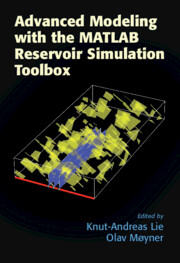Book contents
- Frontmatter
- Contents
- List of Contributors
- Preface
- Acknowledgments
- Navigating the Book and the MRST Modules
- Part I Grid Generation, Discretizations, and Solvers
- Part II Rapid Prototyping and Accelerated Computation
- Part III Modeling of New Physical Processes
- 7 Using State Functions and MRST’ls AD-OO Framework to Implement Simulators for Chemical EOR
- 8 Compositional Simulation with the AD-OO Framework
- 9 Embedded Discrete Fracture Models
- 10 Numerical Modeling of Fractured Unconventional Oil
- 11 A Unified Framework for Flow Simulation in Fractured Reservoirs
- 12 Simulation of Geothermal Systems Using MRST
- 13 A Finite-Volume-Based Module for Unsaturated Poroelasticity
11 - A Unified Framework for Flow Simulation in Fractured Reservoirs
from Part III - Modeling of New Physical Processes
Published online by Cambridge University Press: 20 November 2021
- Frontmatter
- Contents
- List of Contributors
- Preface
- Acknowledgments
- Navigating the Book and the MRST Modules
- Part I Grid Generation, Discretizations, and Solvers
- Part II Rapid Prototyping and Accelerated Computation
- Part III Modeling of New Physical Processes
- 7 Using State Functions and MRST’ls AD-OO Framework to Implement Simulators for Chemical EOR
- 8 Compositional Simulation with the AD-OO Framework
- 9 Embedded Discrete Fracture Models
- 10 Numerical Modeling of Fractured Unconventional Oil
- 11 A Unified Framework for Flow Simulation in Fractured Reservoirs
- 12 Simulation of Geothermal Systems Using MRST
- 13 A Finite-Volume-Based Module for Unsaturated Poroelasticity
Summary
Simulation of multiphase flow in fractured reservoirs still poses a challenge due to the different timescales of fluid flow in fractures and matrix. Common approaches to modeling fractures in reservoir simulators include the discrete fracture and matrix (DFM) method, where the fractures are explicitly represented as lower-dimensional elements in the computational mesh, and multicontinuum approaches (e.g., dual-porosity and dual-permeability models) where the behavior of the fractures and matrix are integrated and treated as distinct continua. The latter requires models (bespoke “transfer functions”) that upscale the multiphase transfer between fracture and matrix. There are several formulations for transfer functions available in the literature, and they are often application dependent. Here, we propose a unified framework for simulation of flow in fractured media. The framework makes no distinction between dual-continuum and DFM methods, treating fractures and one or more matrix domains as flowing domains and virtual domains. Transfer functions are reinterpreted as fluxes between cells of different domains. This enables us to create an abstraction that encompasses both methods and makes it easy to build hybridized models including different regions with different matrix/fracture interaction concepts. We present a series of cases to illustrate the main differences between both modeling approaches and the benefit of a flexible implementation that enables the development of a fit-for-purpose simulator for fractured reservoirs.
Keywords
- Type
- Chapter
- Information
- Advanced Modeling with the MATLAB Reservoir Simulation Toolbox , pp. 454 - 490Publisher: Cambridge University PressPrint publication year: 2021
- Creative Commons
- This content is Open Access and distributed under the terms of the Creative Commons Attribution licence CC-BY-NC-ND 4.0 https://creativecommons.org/cclicenses/
- 4
- Cited by

